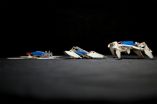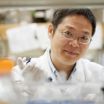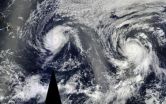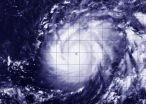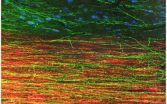(Press-News.org) A team of engineers used little more than paper and Shrinky dinks™ – the classic children's toy that shrinks when heated – to build a robot that assembles itself into a complex shape in four minutes flat, and crawls away without any human intervention. The advance, described in Science, demonstrates the potential to quickly and cheaply build sophisticated machines that interact with the environment, and to automate much of the design and assembly process. The method draws inspiration from self-assembly in nature, such as the way linear sequences of amino acids fold into complex proteins with sophisticated functions.
"Getting a robot to assemble itself autonomously and actually perform a function has been a milestone we've been chasing for many years," said senior author Rob Wood, Ph.D., a Core Faculty member at the Wyss Institute for Biologically Inspired Engineering at Harvard University and the Charles River Professor of Engineering and Applied Sciences at Harvard's School of Engineering and Applied Sciences (SEAS). The team included engineers and computer scientists from the Wyss Institute, SEAS, and the Massachusetts Institute of Technology (MIT).
In addition to expanding the scope of ways one can manufacture robots in general, the advance harbors potential for rather exotic applications as well.
"Imagine a ream of dozens of robotic satellites sandwiched together so that they could be sent up to space and then assemble themselves remotely once they get there–they could take images, collect data, and more," said lead author Sam Felton, who is pursuing his Ph.D. at SEAS.
The robots are the culmination of a series of advances made by the team over the last few years, including development of a printed robotic inchworm – which still required human involvement while folding itself – and a self-folding lamp that had to be turned on by a person after it self-assembled.
The new robot is the first that builds itself and performs a function without human intervention.
"Here we created a full electromechanical system that was embedded into one flat sheet," Felton said. The team used computer design tools to inform the optimal design and fold pattern – and after about 40 prototypes, Felton honed in on the one that could fold itself up and walk away. He fabricated the sheet using a solid ink printer, a laser machine, and his hands.
The refined design only took about two hours to assemble using a method that relies upon the power of origami, the ancient Japanese art whereby a single sheet of paper can be folded into complex structures. The origami-inspired approach enabled the team to avoid the traditional "nuts and bolts" approach to assembling complex machines.
They started with a flat sheet, to which they added two motors, two batteries, and a microcontroller – which acts like the robot's "brain," Felton said.
The sheet was a composite of paper and Shrinky dinks™, which is also called polystyrene -- and a single flexible circuit board in the middle. It also included hinges that were programmed to fold at specific angles. Each hinge contained embedded circuits that produce heat on command from the microcontroller. The heat triggers the composite to self-fold in a series of steps.
When the hinges cool after about four minutes, the polystyrene hardens -- making the robot stiff – and the microncontroller then signals the robot to crawl away at a speed of about one-tenth of a mile per hour. The entire event consumed about the same amount of energy in one AA alkaline battery.
The current robot operates on a timer, waiting about ten seconds after the batteries are installed to begin folding. However, "we could easily modify this such that the folding is triggered by an environmental sensor, such as temperature or pressure," Felton said.
One of the primary challenges in the process, Felton said, was the propensity for the robots to burn up before they folded up properly; each one runs on about ten times the current that typically runs through a light bulb.
"There is a great deal that we can improve based on this foundational step," said Felton, who plans to experiment with different kinds of shape memory polymers – materials like the polystyrene – that are stronger and require less heat to activate, for example.
The method is complementary to 3D printing, which also holds great promise for quickly and inexpensively manufacturing robotic components but struggles to integrate the electrical components and in this specific case, would have taken a lot longer to produce the functional prototype.
The long-term dream of this work, Wood said, is to have a facility that everyone could access around the clock in their communities when they might have a need for robotic assistance, from everyday house and porch sweeping to detecting gas leaks in the neighborhood. "You would be able to come in, describe what you need in fairly basic terms, and come back an hour later to get your robotic helper," Wood said. All told, each robot cost about $100, but only $20 for the body without the motors, batteries, and microcontroller.
"This achievement by Rob and his team change the way we think about manufacturing in that the machine fabricates itself," said Wyss Institute Founding Director Don Ingber, M.D., Ph.D. "The days of big, rigid, robots that sit in place and carry out the same repetitive task day in and out are fading fast."
INFORMATION:
This work was funded by the National Science Foundation, the Wyss Institute for Biologically Inspired Research at Harvard University, and the Department of Defense, Air Force Office of Scientific Research, National Defense Science and Engineering Graduate (NDSEG) Fellowship.
IMAGES AND VIDEO AVAILABLE
About the Wyss Institute for Biologically Inspired Engineering at Harvard University
The Wyss Institute for Biologically Inspired Engineering at Harvard University uses Nature's design principles to develop bioinspired materials and devices that will transform medicine and create a more sustainable world. Working as an alliance among all of Harvard's Schools, and in partnership with Beth Israel Deaconess Medical Center, Brigham and Women's Hospital, Boston Children's Hospital, Dana Farber Cancer Institute, Massachusetts General Hospital, the University of Massachusetts Medical School, Spaulding Rehabilitation Hospital, Boston University, Tufts University, and Charité - Universitätsmedizin Berlin, and the University of Zurich, the Institute crosses disciplinary and institutional barriers to engage in high-risk research that leads to transformative technological breakthroughs. By emulating Nature's principles for self-organizing and self-regulating, Wyss researchers are developing innovative new engineering solutions for healthcare, energy, architecture, robotics, and manufacturing. These technologies are translated into commercial products and therapies through collaborations with clinical investigators, corporate alliances, and new start-ups.
About the Harvard School of Engineering and Applied Sciences The Harvard School of Engineering and Applied Sciences (SEAS) serves as the connector and integrator of Harvard's teaching and research efforts in engineering, applied sciences, and technology. Through collaboration with researchers from all parts of Harvard, other universities, and corporate and foundational partners, we bring discovery and innovation directly to bear on improving human life and society. For more information, visit: http://seas.harvard.edu. END
Robot folds itself up and walks away
Demonstrates the potential for sophisticated machines that build themselves
2014-08-07
ELSE PRESS RELEASES FROM THIS DATE:
Origami robot folds itself up, crawls away
2014-08-07
For years, a team of researchers at MIT and Harvard University has been working on origami robots — reconfigurable robots that would be able to fold themselves into arbitrary shapes.
In the August 7 issue of Science, they report their latest milestone: a robot, made almost entirely from parts produced by a laser cutter, that folds itself up and crawls away as soon as batteries are attached to it.
"The exciting thing here is that you create this device that has computation embedded in the flat, printed version," says Daniela Rus, the Andrew and Erna Viterbi Professor ...
NASA sees heavy rainfall in Iselle as the hurricane nears Hawaii
2014-08-07
VIDEO:
TRMM satellite rainfall data overlaid on an enhanced infrared image from NOAA's GOES-West satellite shows heavy rainfall occurring around the Iselle's eye. The most intense rain was falling at a...
Click here for more information.
A NASA satellite has observed heavy rainfall in Hurricane Iselle on its approach to Hawaii. NASA's TRMM Satellite captured rainfall rates within the storm as it passed overhead. In addition, NASA's Aqua satellite provided a larger view of the Central ...
Cell signaling pathway linked to obesity, type 2 diabetes
2014-08-07
WEST LAFAYETTE, Ind. - A Purdue University study shows that Notch signaling, a key biological pathway tied to development and cell communication, also plays an important role in the onset of obesity and Type 2 diabetes, a discovery that offers new targets for treatment.
A research team led by Shihuan Kuang, associate professor of animal sciences, found that blocking Notch signaling in the fat tissue of mice caused white fat cells to transform into a "leaner" type of fat known as beige fat. The finding suggests that suppressing Notch signaling in fat cells could reduce ...
Gut microbes browse along a gene buffet
2014-08-07
DURHAM, N.C. -- In the moist, dark microbial rainforest of the intestine, hundreds of species of microorganisms interact with each other and with the cells of the host animal to get the resources they need to survive and thrive.
Though there's a lot of competition in this vibrant ecosystem, collaboration is valued too. A new study on the crosstalk between microbes and cells lining the gut of mice shows just how cooperative this environment can be.
One of the main ways that hosts manage their interactions with microbes is by carefully controlling the genes that their ...
NASA sees Hurricane Julio organize and emit a gamma-ray flash
2014-08-07
NASA's Fermi and Aqua satellites captured two different views of bursts of strength show by Hurricane Julio as it intensified. NASA's Fermi satellite saw a gamma-ray flash from Julio, while NASA's Aqua satellite saw Julio become more structurally organized as a hurricane.
This type of outburst is known as a terrestrial gamma-ray flash (TGF). Produced by the powerful electric fields in thunderstorms, TGFs last only a few thousandths of a second but emit gamma rays that make up the highest-energy naturally-occurring light on Earth. Scientists estimate that, on average, ...
Wild sheep show benefits of putting up with parasites
2014-08-07
In the first evidence that natural selection favors an individual's infection tolerance, researchers from Princeton University and the University of Edinburgh have found that an animal's ability to endure an internal parasite strongly influences its reproductive success. Reported in the journal PLoS Biology, the finding could provide the groundwork for boosting the resilience of humans and livestock to infection.
The researchers used 25 years of data on a population of wild sheep living on an island in northwest Scotland to assess the evolutionary importance of infection ...
NASA sees Genevieve cross international date line as a Super-Typhoon
2014-08-07
Tropical Storm Genevieve had ups and downs in the Eastern Pacific and Central Pacific over the last week but once the storm crossed the International Dateline in the Pacific, it rapidly intensified into a Super Typhoon. NASA-NOAA's Suomi NPP satellite captured of the storm.
When Suomi NPP flew over Genevieve on August 7 at 01:48 UTC the Visible Infrared Imaging Radiometer Suite (VIIRS) instrument aboard captured an infrared image of the storm. VIIRS collects visible and infrared imagery and global observations of land, atmosphere, cryosphere and oceans. VIIRS flies aboard ...
Dramatic growth of grafted stem cells in rat spinal cord injuries
2014-08-07
Building upon previous research, scientists at the University of California, San Diego School of Medicine and Veteran's Affairs San Diego Healthcare System report that neurons derived from human induced pluripotent stem cells (iPSC) and grafted into rats after a spinal cord injury produced cells with tens of thousands of axons extending virtually the entire length of the animals' central nervous system.
Writing in the August 7 early online edition of Neuron, lead scientist Paul Lu, PhD, of the UC San Diego Department of Neurosciences and colleagues said the human iPSC-derived ...
Human skin cells reprogrammed as neurons regrow in rats with spinal cord injuries
2014-08-07
While neurons normally fail to regenerate after spinal cord injuries, neurons formed from human induced pluripotent stem cells (iPSCs) that were grafted into rats with such injuries displayed remarkable growth throughout the length of the animals' central nervous system. What's more, the iPSCs were derived from skin cells taken from an 86-year-old man. The results, described in the Cell Press journal Neuron, could open up new possibilities in stimulating neuron growth in humans with spinal cord injuries
"These findings indicate that intrinsic neuronal mechanisms readily ...
Cancer study reveals powerful new system for classifying tumors
2014-08-07
Cancers are classified primarily on the basis of where in the body the disease originates, as in lung cancer or breast cancer. According to a new study, however, one in ten cancer patients would be classified differently using a new classification system based on molecular subtypes instead of the current tissue-of-origin system. This reclassification could lead to different therapeutic options for those patients, scientists reported in a paper published August 7 in Cell.
"It's only ten percent that were classified differently, but it matters a lot if you're one of those ...
LAST 30 PRESS RELEASES:
Air pollution exposure and birth weight
Obstructive sleep apnea risk and mental health conditions among older adults
How talking slows eye movements behind the wheel
The Ceramic Society of Japan’s Oxoate Ceramics Research Association launches new international book project
Heart-brain connection: international study reveals the role of the vagus nerve in keeping the heart young
Researchers identify Rb1 as a predictive biomarker for a new therapeutic strategy in some breast cancers
Survey reveals ethical gaps slowing AI adoption in pediatric surgery
Stimulant ADHD medications work differently than thought
AI overestimates how smart people are, according to HSE economists
HSE researchers create genome-wide map of quadruplexes
Scientists boost cell "powerhouses" to burn more calories
Automatic label checking: The missing step in making reliable medical AI
Low daily alcohol intake linked to 50% heightened mouth cancer risk in India
American Meteorological Society announces Rick Spinrad as 2026 President-Elect
Biomass-based carbon capture spotlighted in newly released global climate webinar recording
Illuminating invisible nano pollutants: advanced bioimaging tracks the full journey of emerging nanoscale contaminants in living systems
How does age affect recovery from spinal cord injury?
Novel AI tool offers prognosis for patients with head and neck cancer
Fathers’ microplastic exposure tied to their children’s metabolic problems
Research validates laboratory model for studying high-grade serous ovarian cancer
SIR 2026 delivers transformative breakthroughs in minimally invasive medicine to improve patient care
Stem Cell Reports most downloaded papers of 2025 highlight the breadth and impact of stem cell research
Oxford-led study estimates NHS spends around 3% of its primary and secondary care budget on the health impacts of heat and cold in England
A researcher’s long quest leads to a smart composite breakthrough
Urban wild bees act as “microbial sensors” of city health.
New study finds where you live affects recovery after a hip fracture
Forecasting the impact of fully automated vehicle adoption on US road traffic injuries
Alcohol-related hospitalizations from 2016 to 2022
Semaglutide and hospitalizations in patients with obesity and established cardiovascular disease
Researchers ‘listen in’ to embryo-mother interactions during implantation using a culture system replicating the womb lining
[Press-News.org] Robot folds itself up and walks awayDemonstrates the potential for sophisticated machines that build themselves
